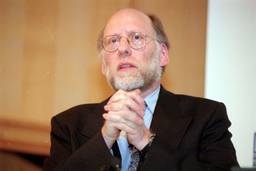Standing in the supermarket checkout line, I’m accosted by a slew of headlines: Has Jon been cheating on Kate? Has Kate been cheating on Jon? Are they going to split up?
My question: Who the hell are these people?! And why should I care? As one of the few people utterly clueless about the TLC hit reality TV series, Jon & Kate Plus 8, about a couple with eight kids, two of them fraternal twins and six of them sextuplets, I didn’t know what to make of these headlines.
And that’s the point. This mindless drivel that dominates America’s magazine racks has now invaded the likes of the Boston Globe, Time, MSNBC, the Detroit Free Press and the Los Angeles Times.
Many of us have become so resigned to the sorry state of the news media in the United States that we feel the downward spiral will only continue, until there’s no hard news at all. Instead, all we’ll get is celebrity news and Crossfire-style, right/left screaming heads in verbal food fights. Maybe it’s inevitable. In a barely regulated “free market” media system that values ratings and profits above all else, this is what you get. And what does it do? Dumb down the population.
This was confirmed in an important new study, Media System, Public Knowledge and Democracy, published in March 2009 and headed by media scholars James Curran and Shanto Iyengar.
The authors compared regulated, government-supported, public service media systems, like those in Denmark and Finland, to the U.S. and U.K. systems, which are hybrid market/public service models. With the spread of U.S. neo-liberalism around the globe, many media systems are becoming more market-oriented and entertainment-focused.
What are the Scandinavian models like, according to the authors? Get this: “The core assumption is that citizens must be adequately exposed to public affairs programming if they are to cast informed votes, hold government to account and be properly empowered.” So, the government subsidizes public broadcasters to provide public affairs programming, and they actually enjoy large audiences.
Curran and Iyengar studied a sample of news sources in these four countries to assess the amount of hard news and soft news in their respective media diets. They also surveyed citizens to measure their awareness of hard and soft news and their knowledge of domestic and international affairs. News items were coded from relatively easy (Americans were expected, for example, to be able to identify the Taliban) to relatively hard (Americans were not expected to know much about the Tamil Tigers separatist movement).
It is hardly surprising to learn that the U.S. news media ranked last in its coverage of international hard news, with only 15 percent of stories devoted to international affairs (nearly half of which were about Iraq). Finland’s international coverage is double. Thus, you’ll be even less surprised that the study found Americans are “especially uninformed about international public affairs,” while the Scandinavians emerged as the best informed.
What do we excel at? Knowledge of soft news and its stars, like Britney Spears and Mel Gibson. Of those surveyed, 90 percent could identify them, whereas 62 percent didn’t know what the Kyoto Accords are. Americans know less about the world than the Finns, Danes or British because we “consume relatively little news in comparison to populations elsewhere.”
In part, this stems from the time slot of our network TV news – early evening, as opposed to prime time in other countries – so it’s harder in the United States to stay informed. I, for one, feel I have to read the New York Times, listen to NPR, watch BBC America, The Newshour, The Daily Show and one of the networks just to patch together what’s happening in the world.
But here’s the kicker: In the European countries there is not a news knowledge gap based on education, income or class. In fact, “disadvantaged groups in Finland, Denmark and Britain know just as much as their more privileged counterparts” and “the contrast is especially notable in relation to education.” In the United States there is a whopping 40 percent gap in knowledge between those with limited education and those with higher education. In Finland, the gap is just 13 percent. In Denmark it is virtually zero.
This is why media reform movements, in our country and elsewhere, remain so important. At their core they are about reversing a trend toward an impoverished public life. This, as we have just witnessed, leads to crises not only in democracy, but even, ironically, in capitalism itself.
Susan J. Douglas is a professor of communications at the University of Michigan and a senior editor at In These Times. She is the author of In Our Prime: How Older Women Are Reinventing the Road Ahead.









